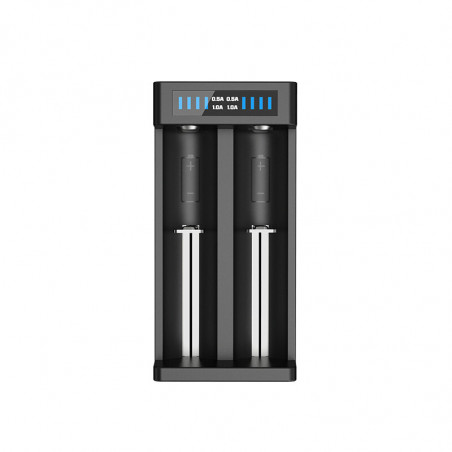














A fully professional processor charger with three-stage TC/CC/CV charging process is hidden in a small case. It charges Li-ion 3.6 / 3.7V cells of any capacity in sizes 10440, 14500, 14650, 16340, 17500, 17670, 18350, 18500, 18650, 18700, 20700, 21700 - unprotected only ,
What is the TC/CC/CV charging method? It is a three-stage charging process for Li-ion cells that ensures that the cell remains in good condition by charging with the right current at each stage and completing the charging process at the right time.
The different stages of the TC/CC/CV process are:
Batteries with a voltage of 4.1V or higher are treated as charged by the charger. To fully charge such a battery, insert it into the charger before turning it on. Charged batteries left in the charger will undergo a natural self-discharge process. Charging will resume when the voltage on the battery drops below 4.1V.
The Xtar MC2 Plus charger has a function to reactivate deeply discharged cells and cells with 0V. Many chargers on the market are unable to charge such batteries. Here with help comes the Xtar MC2 charger, which in many cases allows you to 'salvage' such cells. Simply insert a deeply discharged battery into the MC2 charger, just as you would for normal charging - the charger will detect the discharged cell and attempt to reactivate it. Caution: cells discharged below a certain level are irreversibly damaged and reactivation may not be possible. Avoid discharging Li-ion batteries too deeply - this can significantly reduce their life and capacity or lead to their complete failure.
Chargers from other manufacturers may significantly increase the temperature of charged cells during charging. Excessive heating of the cells can cause them to wear out faster. When designing the MC2 Plus charger, Xtar went a step further than the competition by solving this problem in a simple way: an external power supply was used. As a result, the temperature of the rechargeable battery charged in the MC2 Plus will rise by 15 degrees at most.
Included with the Xtar MC2 Plus charger is a micro USB cable and a carrying case to protect the charger during transport. A power adapter is not included. To power the charger, all you need is any charger with a micro USB cable, such as from a phone, or a USB socket or a computer with a free USB port. The recommended power of the USB power adapter is 2A (2000mA). It is possible to use a 1A charger, but in this case the charging time will be increased.
Key features
Technical data:
*Follow the instructions included with the product.
Xtar is a reputable manufacturer of high-quality Li-ion battery chargers, flashlights and Li-ion batteries. Xtar products are sold in more than 120 countries, including, among others, the USA, Germany, Japan and Russia. Xtar uses the highest quality materials to manufacture its chargers - from the housing plastic to the high-performance electronics. All Xtar chargers have CE certification required for European markets.